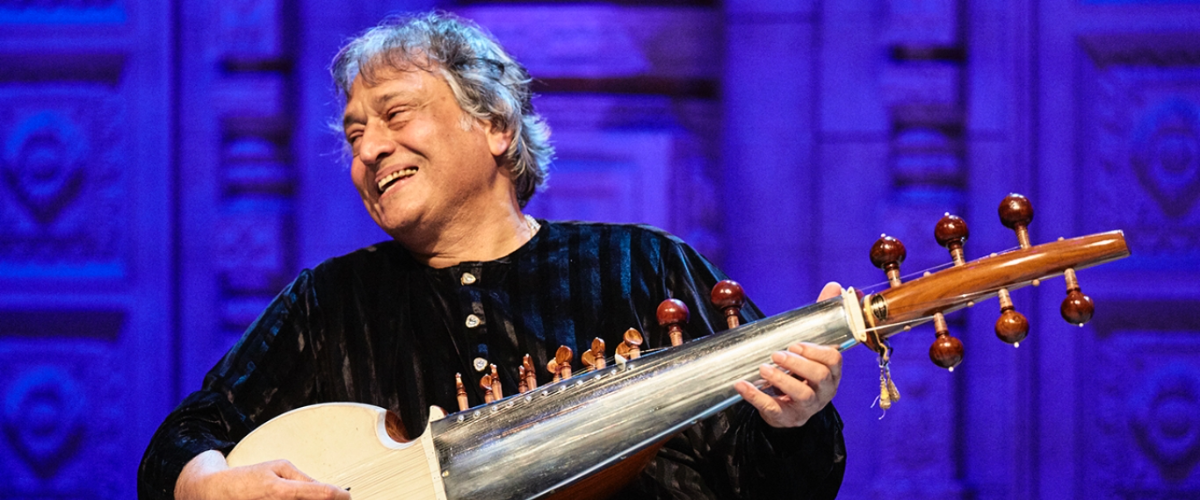

The sarod is a plucked string instrument, now as popular and predominant in North Indian classical music as the sitar. Compared to the sitar, it produces a sound that is somewhat weightier, deeper and more resonant. In the Persian language, the word sarod means ‘beautiful melody'.
Although more than one hereditary Indian music family has claimed to have invented the instrument, it is generally agreed that the sarod is derived from the Afghani rabaab, an instrument of central Asia and especially Afghanistan. But there is also some speculation that the sarod could have descended from the middle-eastern oud. But, whether its origins lie in central Asia or in the Middle East, it is supremely suited to Indian classical music - as a fretless instrument, the facility to slide between notes is greatly enhanced.
But this very lack of frets, coupled with tight and tense strings, makes this one of the most difficult instruments to play, requiring not just wrist action but also considerable strength in the shoulder of playing arm. Instruments can have 20 to 25 strings of which four or five are used for playing the melody, with several more being used as drones or for rhythmic articulation. The rest resonate rather than being played directly. Strings are played by being plucked with a plectrum made out of a triangular piece of coconut shell.
There are two main fretting techniques – one in which the strings are stopped by the fingertips, and the other in which the strings are stopped by the finger nails of the left hand. The second method, now very much predominant, produces a clear, ringing sound but is notoriously difficult. It first became known internationally largely due to the concert appearances of the legendary Ustad Ali Akbar Khan, who made tremendous improvements to the instrument's design and technique. He trained under his father Ustad Allauddin Khan, alongside Pandit Ravi Shankar.
The sarod is shorter than the sitar and appears to rest easily in the performer’s lap. It has two resonating chambers the larger one of which is made of teak and covered with goatskin while the smaller one at the other end is made of metal. The lute itself is made of a single block of wood, consisting of a hollow, circular belly extending into a tapering neck that arches back slightly to end in a peg box. The front of the belly is covered by parchment and the fingerboard, across which the strings are tightly placed, is of highly polished metal.
Listen to the music | Debasmita Bhattacharya is a rising sarod star from Kolkata. Her rendition of the afternoon Raag Bhimpalasi is romantic yet sombre, demonstrating both patience and passion. Recorded by Darbar on location in Guptipara, West Bengal.
Jameela Siddiqi is an author, linguist, and BBC cultural commentator, specialising in postcolonial fiction and the devotional music of South Asia.
Darbar believes in the power of Indian classical music to stir, thrill, and inspire. Explore our YouTube channel, or subscribe to the Darbar Concert Hall to watch extended festival performances, talk and documentaries in pristine HD and UHD quality.
Raag Chandranandan ('Moonstruck') is a modern classic. What does its curious tale tell us about the nature of the...
Read More 
In the centuries-old tradition of Indian classical music, few living legends can claim to have single-handedly made...
Read More 
The sitar is Hindustani music's prime plucked string instrument, and the first one to be widely heard and recognised...
Read More 
The beginner's guide to Indian classical music. Whether you’re completely new to raga music or just need a refresher, we’ve put together this brief overview of all things raga music to help you feel at ease when visiting one of our concerts or watch our videos on our YouTube or our Darbar Concert Hall.
Keep up to date with the latest news, events, music and musings across our social channels
For hundreds more clips and shorts, vist our YT page here 